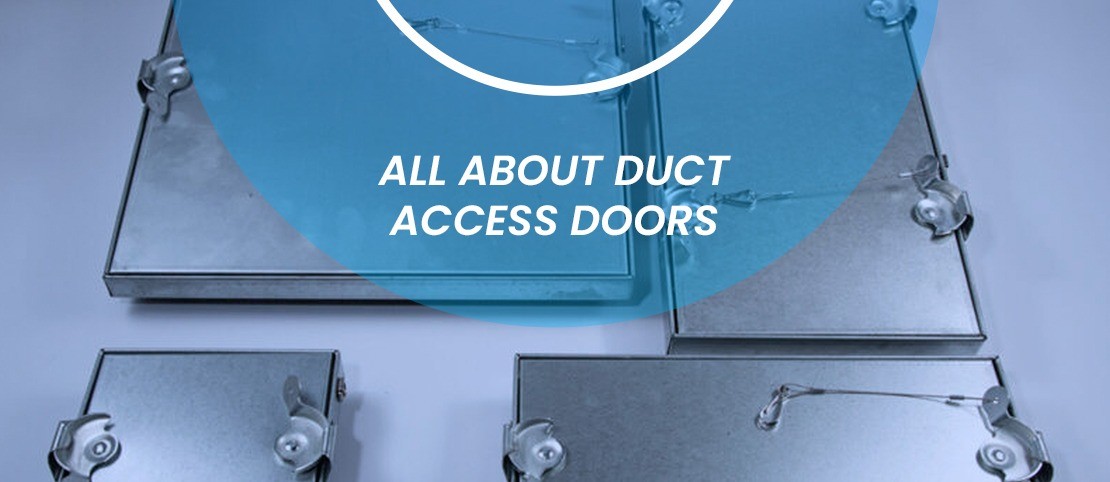All About Duct Access Doors – Types, Installation, Maintenance
If you work in an industry that uses HVAC systems or ductwork, you know that access doors are a crucial component. Duct access doors allow you to reach and maintain the inside of the ductwork, ensuring proper airflow and preventing contamination.
In this guide, we will cover everything you need to know about duct access doors, including types, materials, installation, and maintenance.
Types of Duct Access Doors
When it comes to choosing the right access door for your HVAC system, it's important to consider the type of door that will best suit your specific needs. There are several types of access doors available, each with unique features and benefits. Understanding the different variations of access doors and their applications can help you make an informed decision when selecting the best option for your HVAC system.
Metal Access Doors
These are the most common type of access door and are usually made of steel or aluminum. They are durable and long-lasting, making them ideal for industrial settings. They come in a variety of sizes and can be customized to fit your specific needs.
Plastic Access Doors
These doors are made of high-impact plastic and are often used in residential and commercial settings. They are lightweight and easy to install but may not be as durable as metal access doors.
Fire-Rated Access Doors
These access doors are designed to prevent the spread of fire and smoke through the ductwork. They are made of fire-resistant materials and are tested to withstand high temperatures.
Soundproof Access Doors
If noise is a concern, soundproof access doors can help reduce sound transmission through the ductwork. They are made of sound-absorbing building materials and can be used in recording studios, theaters, and other settings where noise is an issue.
Materials
The materials used in duct access doors can vary depending on the type of door and the specific application. The right material can impact the durability, strength, and weight of the access door. In this section, we will explore the most common materials used in duct access doors, including steel, aluminum, plastic, and fire-resistant materials such as gypsum and ceramic fiber. Understanding the properties of these materials can help you choose the right access door for your specific needs.
Steel
Steel is the most common material used in access doors. It is durable and strong, making it ideal for industrial settings.
Aluminum
Aluminum is a lightweight and corrosion-resistant material that is often used in access doors for HVAC systems.
Plastic
High-impact plastic is often used in access doors for residential and commercial settings because it is lightweight and easy to install.
Installation
Proper installation of duct access doors is essential to ensure they function correctly and prevent air leaks and contamination. In this section, we will walk you through the steps for installing a duct access door, including determining the location, cutting the opening, installing the frame, installing the door, and sealing the edges. We will also provide tips on how to follow manufacturer's instructions and local building codes to ensure your installation is safe and effective.
Determine the location
The first step is to determine the location of the access door. It should be placed in a convenient location for maintenance and inspection.
Cut the opening
Use a saw or other cutting tool to create an opening in the ductwork that is slightly smaller than the access door.
Install the frame
The access door frame is attached to the ductwork using screws or other fasteners. Make sure the frame is securely attached and level.
Install the door
The door is then inserted into the frame and secured using screws or other fasteners.
Seal the edges
Finally, the edges of the access door are sealed using silicone or another sealant to prevent air leaks.
Maintenance
Proper maintenance of duct access doors is essential to ensure they function correctly and prevent contamination. Neglecting maintenance can lead to decreased efficiency, increased energy costs, and health and safety concerns. In this section, we will provide tips for maintaining duct access doors, including regular inspections, cleaning, replacing damaged doors, checking the sealant, and inspecting the ductwork. Following these maintenance guidelines can help you prolong the life of your access doors and ensure the optimal performance of your HVAC system.
Inspect regularly
Regular inspections can help identify any damage or wear to the access door and frame. Inspect at least once a year or more often in high-traffic areas.
Clean the door and frame
Use a damp cloth or mild soap and water to clean the access door and frame. Avoid using harsh chemicals or abrasive cleaners that could damage the door.
Replace damaged doors
If the access door is damaged, replace it as soon as possible to prevent air leaks and contamination. Damaged frames should also be repaired or replaced.
Check the sealant
Check the sealant around the edges of the access door regularly and reapply if necessary to prevent air leaks.
Inspect the ductwork
While inspecting the access door, also inspect the ductwork for any damage or wear that may affect the performance of the HVAC system.
Conclusion
Duct access doors are a crucial component in HVAC systems, allowing for easy maintenance and inspection of the ductwork.
There are several types of access doors available, including metal, plastic, fire-rated, and soundproof options, each with unique features and benefits. Proper installation and maintenance of access doors are essential to ensure they function correctly and prevent air leaks and contamination.
By following these guidelines, you can ensure your duct access doors are installed correctly and maintained properly, ensuring optimal performance of your HVAC system.
Related Posts
Comments
By accepting you will be accessing a service provided by a third-party external to https://www.mbt-techserv.com/



